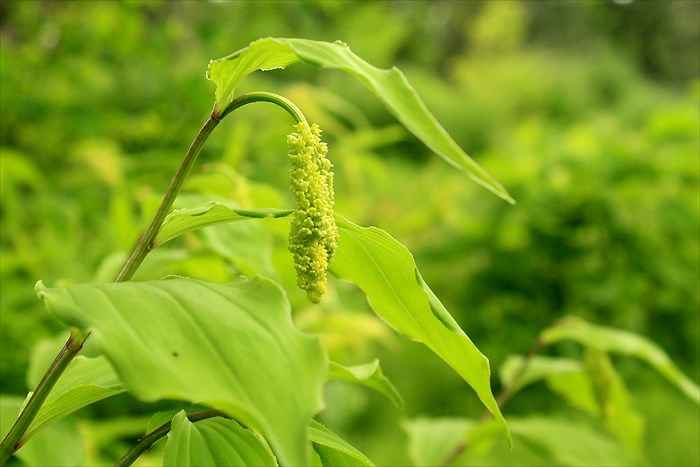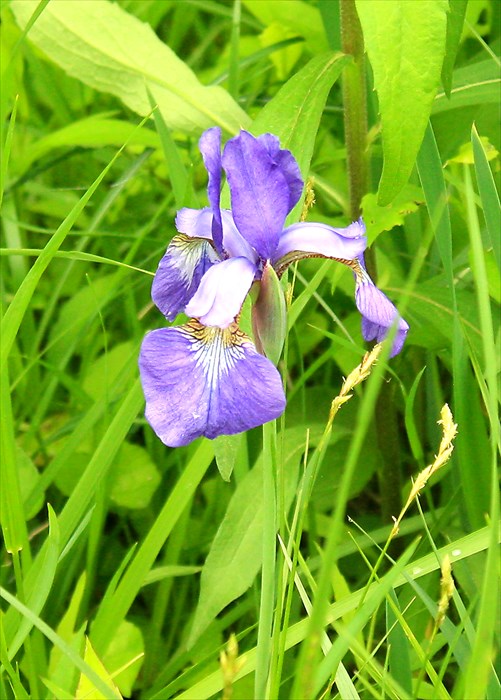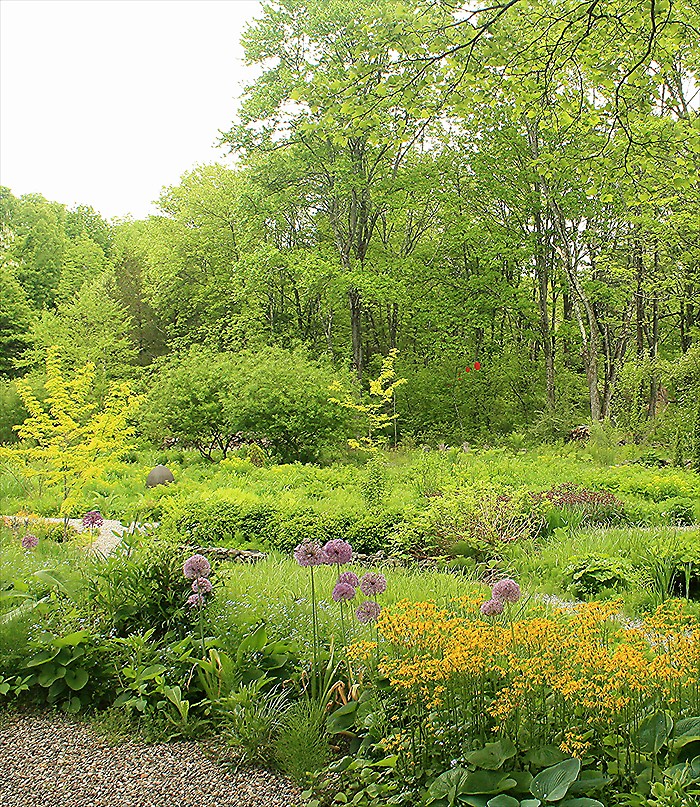No visitors allowed: plant communities emerging

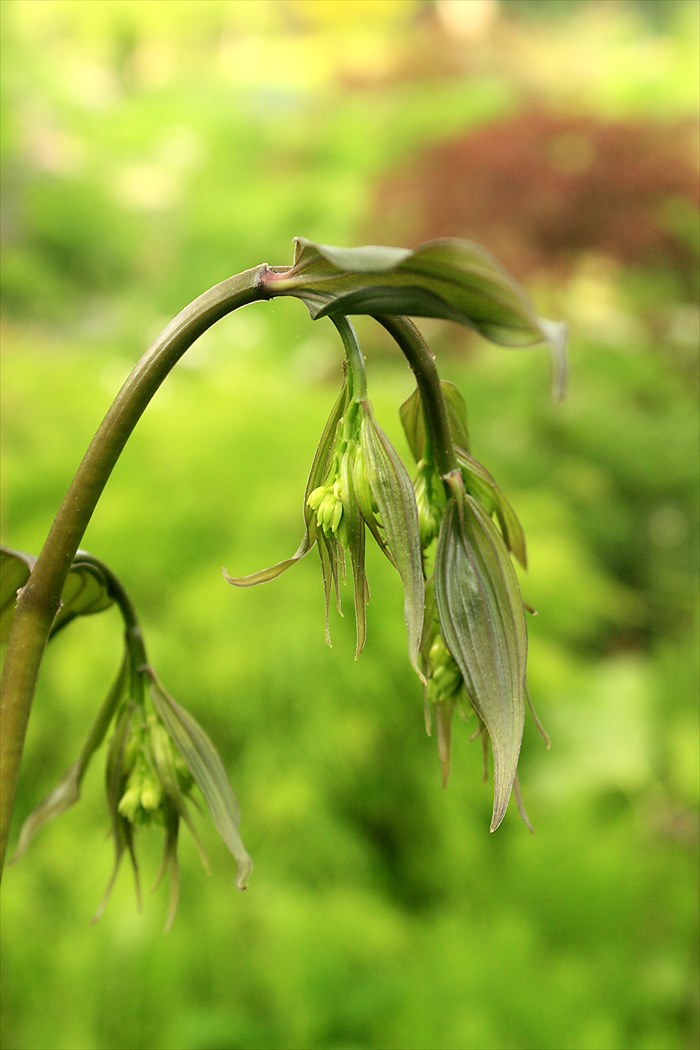 Most of the garden is missing.I have to say "No" when people want to visit Federal Twist at this time of year. Though some interesting things are happening, my garden depends on the structure of large plants for much of its effect. By late June--when it's open for the Garden Conservancy Open Days--it's ready to be seen.But not now.Here's why ... looking across the main area of the garden, the plant layer is low and, from a distance, lacking in interest. Many of these plants will grow to five or ten feet, creating a completely different landscape in a few more weeks.
Most of the garden is missing.I have to say "No" when people want to visit Federal Twist at this time of year. Though some interesting things are happening, my garden depends on the structure of large plants for much of its effect. By late June--when it's open for the Garden Conservancy Open Days--it's ready to be seen.But not now.Here's why ... looking across the main area of the garden, the plant layer is low and, from a distance, lacking in interest. Many of these plants will grow to five or ten feet, creating a completely different landscape in a few more weeks.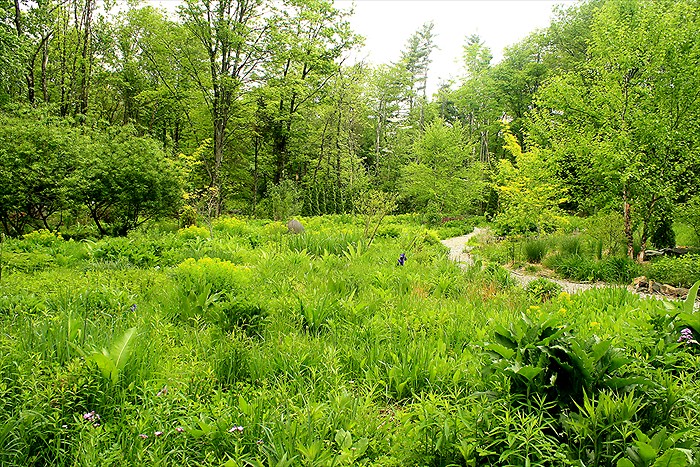 One thing you may be able to see is this: the plants are growing in a thick mat. Over the years, they have formed plant communities and, though there is constant change, the overall planting is self-sustaining--with some input from me, editing here and there, and engaging in occasional battle against annual weeds such as Japanese Stilt Grass (Microstegeum vimenium).But to find interest at this time of year, you need to observe details, get close up. Here, a cutleaf Japanese maple, and two plants endemic to this site, Sensitive fern (Onoclea sensibilis) and a small Horsetail (Equisetum arvense). The Equisetum looks like a problem, but it isn't. It doesn't seem to have much effect at all on the other garden plants, it forms a very effective ground cover layer, and it makes a beautiful textured background. A winner in my book.
One thing you may be able to see is this: the plants are growing in a thick mat. Over the years, they have formed plant communities and, though there is constant change, the overall planting is self-sustaining--with some input from me, editing here and there, and engaging in occasional battle against annual weeds such as Japanese Stilt Grass (Microstegeum vimenium).But to find interest at this time of year, you need to observe details, get close up. Here, a cutleaf Japanese maple, and two plants endemic to this site, Sensitive fern (Onoclea sensibilis) and a small Horsetail (Equisetum arvense). The Equisetum looks like a problem, but it isn't. It doesn't seem to have much effect at all on the other garden plants, it forms a very effective ground cover layer, and it makes a beautiful textured background. A winner in my book.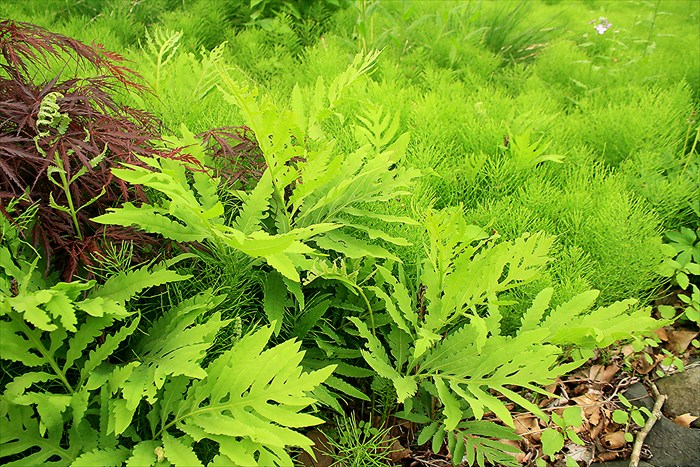 More Sensitive fern and Lady's Mantle (Alchemilla mollis), an introduced plant, along the long stone wall.
More Sensitive fern and Lady's Mantle (Alchemilla mollis), an introduced plant, along the long stone wall. Persicaria bistorta 'Superba', often reviled by British gardeners as unacceptably invasive. In my soil, it's really tame. It's taken five or six years to get it to cover this small four-foot circle. This import has become a favorite. Regardless of place of origin, its made for the conditions in my garden.
Persicaria bistorta 'Superba', often reviled by British gardeners as unacceptably invasive. In my soil, it's really tame. It's taken five or six years to get it to cover this small four-foot circle. This import has become a favorite. Regardless of place of origin, its made for the conditions in my garden. Here is another favorite, Ligularia japonica, an extraordinarily beautiful plant (I have several). The background is an expanse of Equisetum, dotted with rapidly growing self-seeded Filipendula ulmaria, Sanguisorba canadensis (which I encouraged by spreading seed), and two large clumps of self-seeded Cup plant (Silphium perfoliatum), a classic prairie native, at the back.
Here is another favorite, Ligularia japonica, an extraordinarily beautiful plant (I have several). The background is an expanse of Equisetum, dotted with rapidly growing self-seeded Filipendula ulmaria, Sanguisorba canadensis (which I encouraged by spreading seed), and two large clumps of self-seeded Cup plant (Silphium perfoliatum), a classic prairie native, at the back. At a path edge, more Sensitive fern, a native iris, and self-seeded Ironweed (Vernonia noveboracensis) and the large-leaved Inula racemosa 'Sonnenspeer'. Both the Ironweed and Inula will shoot up to great heights by summer's end, totally dominating this little plant community. Change here will be rapid. I'll keep watch and intervene if necessary.
At a path edge, more Sensitive fern, a native iris, and self-seeded Ironweed (Vernonia noveboracensis) and the large-leaved Inula racemosa 'Sonnenspeer'. Both the Ironweed and Inula will shoot up to great heights by summer's end, totally dominating this little plant community. Change here will be rapid. I'll keep watch and intervene if necessary.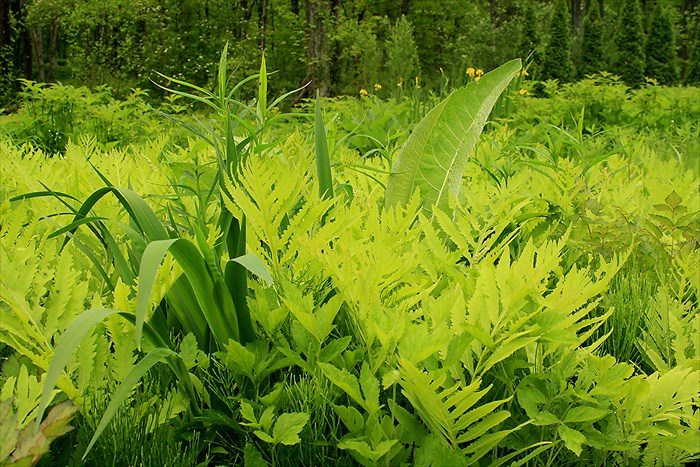 An edge-on view of a massive grouping of Filipendula rubra 'Venusta', which was planted in one forty-foot-long swath about six years ago. It's now developed into four or five masses, living in successful competition with the tall Joe Pye Weed, asters, Rudbeckia maxima, and many other plants. The change has been rather dramatic as stable plant communities have formed, but the effect when the Filipendula is mature and in bloom still reads as a single mass. I much prefer the structural form and foliage of this plant to the rather garish blossom, which fortunately quickly fades to a beautiful bronze seed head. This plant community is a real success story. After my initial placement, the plants have worked out their own living arrangements through competition and mutual adjustment, and altered their distribution to grow most successfully.
An edge-on view of a massive grouping of Filipendula rubra 'Venusta', which was planted in one forty-foot-long swath about six years ago. It's now developed into four or five masses, living in successful competition with the tall Joe Pye Weed, asters, Rudbeckia maxima, and many other plants. The change has been rather dramatic as stable plant communities have formed, but the effect when the Filipendula is mature and in bloom still reads as a single mass. I much prefer the structural form and foliage of this plant to the rather garish blossom, which fortunately quickly fades to a beautiful bronze seed head. This plant community is a real success story. After my initial placement, the plants have worked out their own living arrangements through competition and mutual adjustment, and altered their distribution to grow most successfully. And here another edge-on view showing an Astilbe 'Purple Lance' at front and a Euphorbia palustris beside Marc Rosenquist's bronze sculpture, which serves as the metaphorical center of the garden.
And here another edge-on view showing an Astilbe 'Purple Lance' at front and a Euphorbia palustris beside Marc Rosenquist's bronze sculpture, which serves as the metaphorical center of the garden.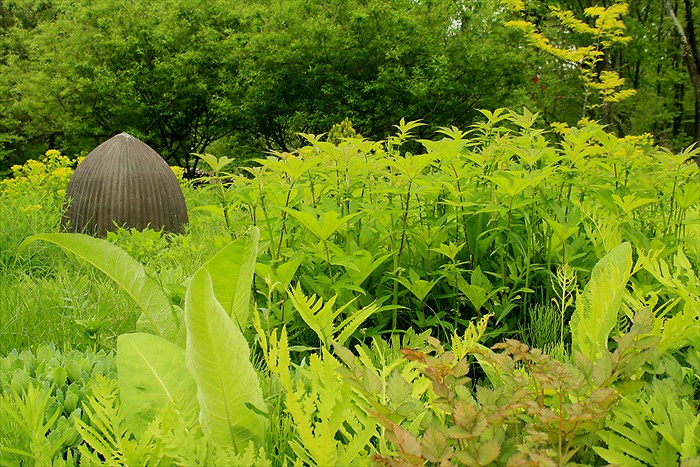 Another area where competitive plants are doing a slow battle dance. Within a matrix of Equisetum, Sensitive fern, Iris pseudacorus, Sanguisorba, seedling Filipendula ulmaria, a Miscanthus yet to fully emerge, and even a couple of Sagittaria, which I must pull out. Now that is a plant I consider too invasive--at least in my difficult soil--to allow free rein. I'll eventually intervene here, after I see what the plants want to do on their own. Maybe the winners will take care of themselves, maybe not.
Another area where competitive plants are doing a slow battle dance. Within a matrix of Equisetum, Sensitive fern, Iris pseudacorus, Sanguisorba, seedling Filipendula ulmaria, a Miscanthus yet to fully emerge, and even a couple of Sagittaria, which I must pull out. Now that is a plant I consider too invasive--at least in my difficult soil--to allow free rein. I'll eventually intervene here, after I see what the plants want to do on their own. Maybe the winners will take care of themselves, maybe not. Darmera peltata, below, isn't the most vigorous plant in my garden, but manages to hold its own against the more competitive Petasites. Here it's just fine beside the pond. I may eventually have to bring in more if it succumbs to the competition, but I like it enough to do that.
Darmera peltata, below, isn't the most vigorous plant in my garden, but manages to hold its own against the more competitive Petasites. Here it's just fine beside the pond. I may eventually have to bring in more if it succumbs to the competition, but I like it enough to do that.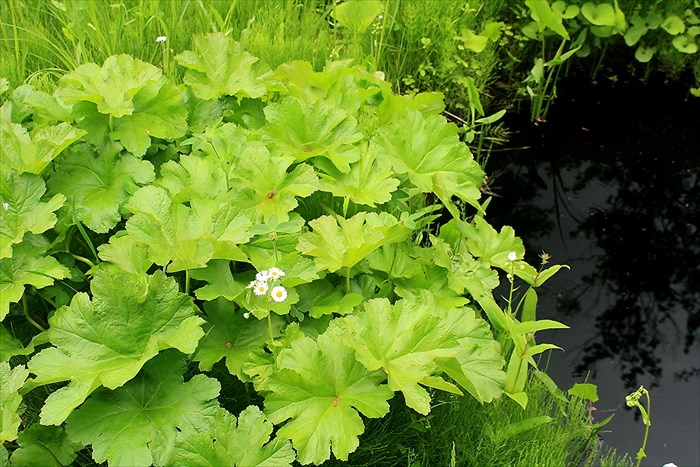 Two native invaders--Spartina pectinata 'Aureomarginata' (Prairie cord grass) and Equisetum--are coexisting easily. The Spartina has such tough rhizomes, it's difficult to control without wholesale digging, but so far I've kept it in aesthetic balance.
Two native invaders--Spartina pectinata 'Aureomarginata' (Prairie cord grass) and Equisetum--are coexisting easily. The Spartina has such tough rhizomes, it's difficult to control without wholesale digging, but so far I've kept it in aesthetic balance.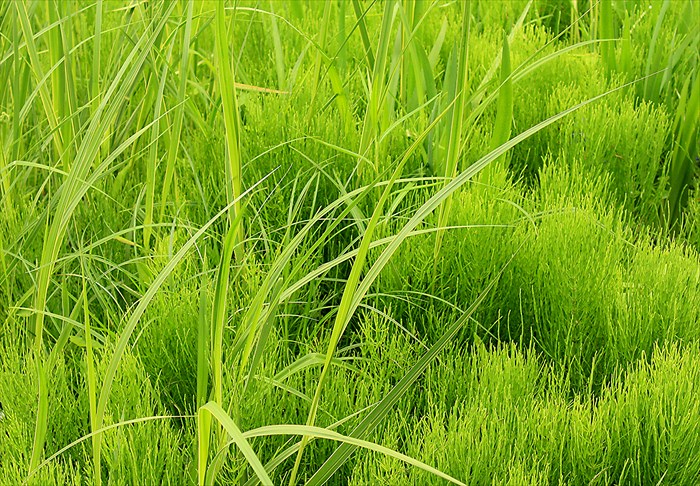 One of many Sanguisorbas that have seeded around the pond. This is the common Sanguisorba canadensis. I encourage it for the white candles of bloom in autumn.
One of many Sanguisorbas that have seeded around the pond. This is the common Sanguisorba canadensis. I encourage it for the white candles of bloom in autumn.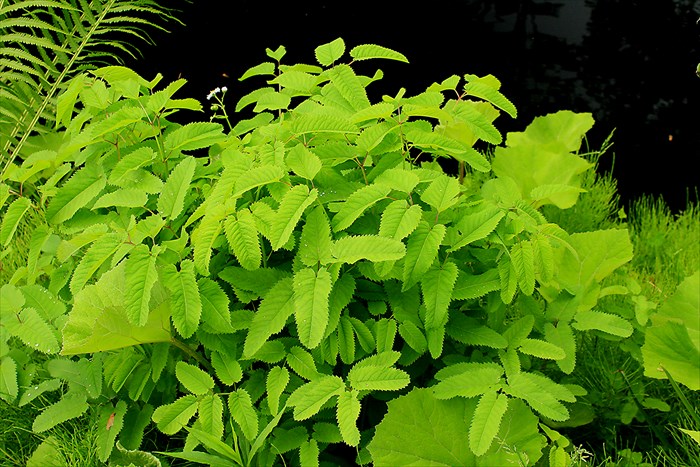 Also beside the pond, a self-seeded Penstemon digitalis, also indigenous to this place.
Also beside the pond, a self-seeded Penstemon digitalis, also indigenous to this place. Smilacina just coming into bloom on the bank near the pond. I went to Paxson Hill Farm to get more this afternoon only to learn that David Culp had just stopped by and purchased two of the three in stock. I should have grabbed them last week.
Smilacina just coming into bloom on the bank near the pond. I went to Paxson Hill Farm to get more this afternoon only to learn that David Culp had just stopped by and purchased two of the three in stock. I should have grabbed them last week.
One of the first irises to bloom, an unidentified Siberian.
But the native irises are more interesting for the long term. The flowering is brief, but their spiky foliage adds a lot of visual interest, and it lasts all season. All of the irises settle well into whatever community of plants they are placed in, unless totally overwhelmed by height and broad foliage. They certainly would not make successful companions with the giant Inula racemosa.
This native Geranium maculatum isn't exactly a spring ephemeral, but it has only a brief early season. It returns reliably year after year, and seems to move around almost imperceptibly. A quiet, inconspicuous plant compared to most of the highly structured plants in the garden. It lives well in community with the other plants, and fades into the background after flowering. Here in the woodland garden, I'm using shade tolerant plants to create a community, and it's happening piecemeal. Most visible now is Golden ragwort (Packera aurea), with various ferns, grasses and carex. The Japanese maples are in elevated stone beds, where I've added a variety of shade plants that can't tolerate the totally saturated ground in this area--Darmera peltata, Rodgersia, Disporum, Dicentra, Polygonatum, and other things--a mess of plants I'll have to sort out later this year.
Here in the woodland garden, I'm using shade tolerant plants to create a community, and it's happening piecemeal. Most visible now is Golden ragwort (Packera aurea), with various ferns, grasses and carex. The Japanese maples are in elevated stone beds, where I've added a variety of shade plants that can't tolerate the totally saturated ground in this area--Darmera peltata, Rodgersia, Disporum, Dicentra, Polygonatum, and other things--a mess of plants I'll have to sort out later this year. The transition to the sunlit part of the garden--from the Packera to a small sea of Petasites in broken sunlight. The composition of the plant communities changes in the foreground where there is much more light.
The transition to the sunlit part of the garden--from the Packera to a small sea of Petasites in broken sunlight. The composition of the plant communities changes in the foreground where there is much more light. I've made no mention of the topmost layers of the garden, the upper layers that are woody and therefore present in all seasons, unlike the as yet unrealized potential of the big herbaceous perennials. Looking across the width of the garden, from the Viburnum plicatum 'Mariesii' to a Sunburst honey locust, a hanging mobile in red, then the forest edge, you see the boundaries and signposts that define the garden as a forest-edge community. The camera foreshortens distance, making a depth of over 200 feet appear to be flat.
I've made no mention of the topmost layers of the garden, the upper layers that are woody and therefore present in all seasons, unlike the as yet unrealized potential of the big herbaceous perennials. Looking across the width of the garden, from the Viburnum plicatum 'Mariesii' to a Sunburst honey locust, a hanging mobile in red, then the forest edge, you see the boundaries and signposts that define the garden as a forest-edge community. The camera foreshortens distance, making a depth of over 200 feet appear to be flat.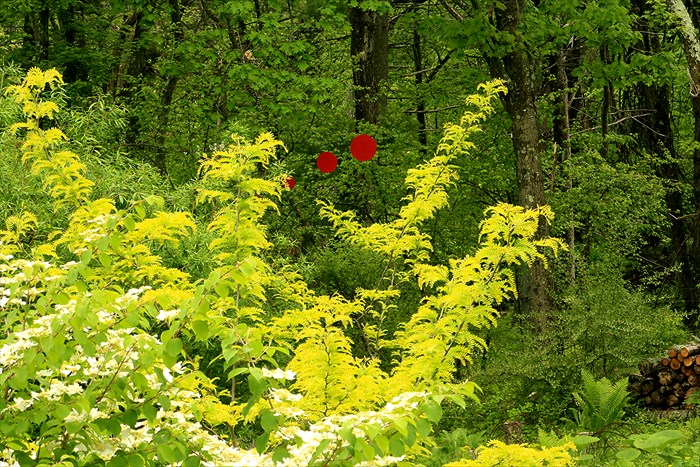 A long view gives a better approximation of relative distance and height and also shows, again, that the garden's detail, its life, disappears on such a large scale. So I await the maturing of the characterful large perennials to fill out the scene.
A long view gives a better approximation of relative distance and height and also shows, again, that the garden's detail, its life, disappears on such a large scale. So I await the maturing of the characterful large perennials to fill out the scene.
Next up, after this month-long interregnum in blog posting, will be a meditation on Thomas Rainer's March lecture at the New York Botanical Garden. The subject? Designed plant communities.
